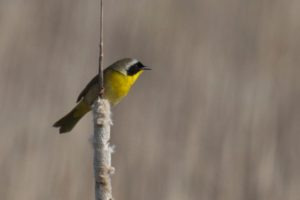
Common yellowthroat warbler (male)
The following was written by Breanna Gosh, summer naturalist intern.
The Ongoing Journey of a Beginning Birder
As a summer intern at Woodland Dunes, I am asked to set goals that I would like to accomplish throughout the duration of my internship. Given that I am the education intern, the majority of my goals relate to education in some way, shape, or form. I also like to set some personal goals for myself in order to get the most out of my internship and better myself in other ways, too.
My personal goal this summer is to become more familiar with birds. After last summer at Woodland Dunes, I am more comfortable identifying the popular backyard birds that I frequently see flying around my yard and eating at the feeders. I feel confident identifying those birds as I see them fly in front of the window, but I still have many more birds to learn about. As a beginning birder, I have continually struggled with tuning into one specific bird song. Walking on Cattail Trail at Woodland Dunes, I am surrounded by hundreds of birds singing their beautiful, unique songs. The first bird song I learned last summer was the ever-present Redwinged Blackbird. Walking out near the marsh, their song, which sounds a lot like “vote for meeee!” can be heard from any direction; it isn’t hard to spot the source of the song either, for the male Redwinged Blackbirds are usually miraculously balancing on a cattail singing out to the females!
Another problem that I routinely experience as a beginning birder is being able to identify birds that look somewhat similar. There are a few birds that have very similar coloring but may have different beaks or tails that set them apart. I tend to focus on the coloring of the bird rather than its body structure which leads to misidentifications. Amidst my many struggles as a beginning birder, I have actively researched and applied advice and helpful hints to better myself as a birder.
Tip #1: Own a field guide and actually open it up! I have a Wisconsin bird guide on a table at home and I open it up randomly throughout the afternoon and evening and browse through it, studying the birds and what makes them unique.
Tip #2: Go on bird surveys! Throughout the past two summers, I have had the opportunity to go on bird walks and bird surveys with Woodland Dunes staff and other bird enthusiasts! Watching an experienced birder decode the chorus of birds singing and identify each bird by its call is truly remarkable. Learning from an expert birder is probably one of the easiest ways to learn.
Tip #3: Record findings. It is a great idea to keep a bird journal, or take a clipboard on bird walks like we do here at Woodland Dunes! Taking notes will make it a lot easier to look back on later.
Tip #4: Bring the birds to YOU! There are certain flowers, bird seeds, fruit, etc. that attract certain bird species. By purposely planting these things, it will bring in new species to your backyard. Birding is a wonderful, lifelong hobby in which there is always more to learn. I have quickly discovered that the birds of Wisconsin are very intriguing and that it is definitely worth getting to know them. Every birder’s journey is different and I can’t wait to continue mine!
If you are interested in learning more about birding, check out the Woodland Dunes website or stop in for a Friday morning bird walk at 8:15 a.m., weather permitting. http://www.woodlanddunes.org/birding101/
Photo is a common yellowthroat warbler taken by Nancy Nabak at Woodland Dunes.
